Engaged Anthropology Grant: Paula Tallman
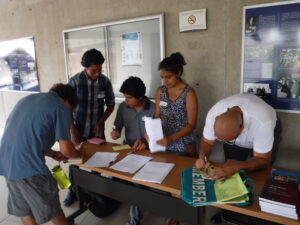
While a doctoral student at Northwestern University Paula Tallman received a Dissertation Fieldwork Grant in 2012 to aid research on “Stress, Health, and Physiological Functioning in the Awajun of the Peruvian Amazon” supervised by Dr. Thomas W. McDade. Following that Dr. Tallman received an Engaged Anthropology Grant in 2015 to aid engaged activities on “Vulnerability & Health Outcomes in Amazonia: An Innovative Conference Engaging Peruvian Scholars, Policy-Makers, & Indigenous Community Members”.
On the morning of Feb. 25th, 2016 representatives from academic, non-governmental, and indigenous organizations converged on the campus of the University of Cayetano Peru Heredia (UPCH) in Lima, Peru. Edilberto Kinin, an Awajún community member and an economist working for the Peruvian Ministry of the Environment arrived in full traditional regalia. His necklaces, made from Amazonian Huayruro seeds, clinked together as he expressed his excitement at presenting at our conference, “Vulnerability and Health Outcomes in Amazonia”, which was sponsored by the Wenner-Gren Engaged Anthropology Grant and UPCH’s School of Public Health.
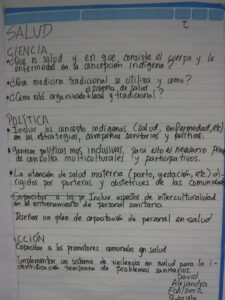
Drs. Paula Skye Tallman (The Field Museum of Natural History) and Armando Valdés-Velasquez (UPCH) organized the event and aimed to cross cultural and institutional boundaries in the pursuit of three objectives. First, we sought to bring together scholars from across the globe to share their most recent research on vulnerability in the Amazon. To that end, we opened our conference with a greeting from UPCH’s Director of Science and Technology, Carlos Zamudio, and we heard presentations from academics from Tulane University (U.S.), the University of Geneva (Switzerland), and UPCH (Peru). Specifically, researchers Giuliana Sanchez and Alejandra Bussalleu discussed their work investigating vulnerability in relationship to dietary changes, public health scientist, Dr. Gabriella Salmon, detailed her team’s research on vulnerability among communities living on the Inter-Oceanic Highway, and neuroscientist David Chaupis Meza spoke about the timely issue of how oil spills create neurodevelopmental vulnerability among indigenous peoples.
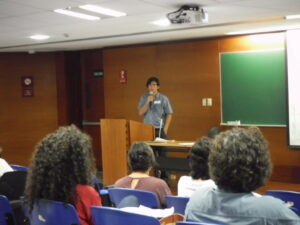
Second, I wanted to ensure that indigenous voices were central to these discussions, alternating between academic and local perspectives during the presentations. Thus, the presentations were kicked off by Mr. Diogenes Ampam, an Awajún community member and the chief manager of two national parks in the Northern Peruvian Amazon. Mr. Ampam connected environmental concerns to vulnerability through his presentation on “The Forest is Our Life and Our Sustainable Development”. Mr. Ampam’s colleague, Mr. Edilberto Kinin, also a chief manager of a park and indigenous communal reserve, presented later in the morning and focused on how vulnerability is being created by climate change in Awajún communities. Specifically, Mr. Kinin highlighted the vulnerability of women who are often responsible for providing water and food for the household, which are becoming scarcer with climate change.
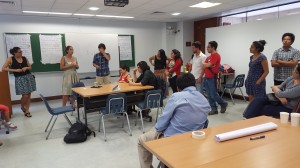
Later in the afternoon, Mr. Leonardo Tello, a spokesperson for the radio station Ucamara in the Amazonian city of Nauta, gave one of the most dynamic and provocative presentations of the conference. Mr. Tello explored the spiritual repercussions of large-scale development projects such as the hydrovia (water highway) for the Kukama people. Particularly, he explained that Kukuma people envision that the spirits of their ancestors live in the rivers and that when the rivers are polluted or compromised through infrastructure development, the well-being of their ancestors is threatened. This presentation yielded new perspectives on how indigenous health goes beyond the physical body. It also provided an exciting path forward for connecting cultural beliefs to government policy as Mr. Imaina is creating cultural and spiritual maps of the Marañon River to argue that the indigenous cosmovision should precede infrastructure development in the rivers.
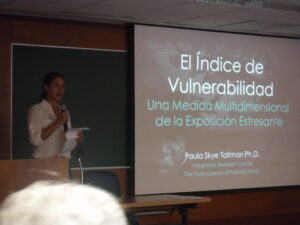
The third and final objective of the conference was to use the scientific perspective on vulnerability and the indigenous perspective on health to think through the potential repercussions of the construction of a series of hydroelectric dams on the Marañon River. Thus on the second day of our event we had a combination of scientists, community members, and indigenous leaders speak about the potential consequences of the proposed dams. Mariana Montoya from the Wildlife Conservation Society started us off by using interactive maps to show how the dams would disrupt the migration patterns of several types of fish that are central food sources for indigenous Amazonian peoples living downstream.
We also saw that the proposed dams would influence upstream mestizo communities as Socorro Quiroz Rocha, from the community of Celendin, spoke of the social fragmentation that was resulting in her community as a result of preliminary work by the dam companies. Finally, Gil Inoach Shawit, former president of AIDESEP (the largest national indigenous rights organization in Peru) spoke of the ecological effects that the dams would have on the lives of Awajún and Wampi community members, but he put this issue into the larger context of ecosocial threats to the Amazon such as oil exploitation, mining, highway construction, palm oil cultivation, and hydrovias.
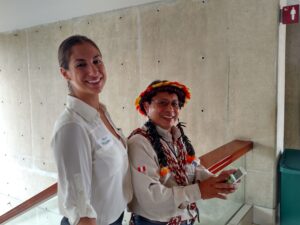
These final presentations inspired the development of inter-institutional alliances that will allow differing stakeholders to work together towards a common cause. For example, members of Remando Juntos, an initiative led by kayakers and conservationists, presented a documentary on their work advocating for the protection of the Marañon River. Mr. Ampam, who works for the Peruvian Ministry of the Environment, invited Remando Juntos to screen their documentary in Awajún communities in the Marañon basin in the coming months. This alliance will bring grass-roots movements based in Lima together with local peoples in the Marañon basis to create awareness of the potential repercussions of the dams, alternative forms of development, and potential avenues for social change.
Post-conference we are creating three concrete products. First, we are working with the Wildlife Conservation Society to produce a one-page informational flyer on the potential social and biological repercussions of the proposed dams on upstream and downstream communities. We will partner with Remando Juntos to distribute these flyers to people attending the screening of their documentary. Second, we are writing an academic article, based on the conference, that is focused on the challenges of working across cultural and disciplinary lines to study vulnerability. And finally, this final report is being translated into Spanish and will distributed via university bulletins in Lima and via radio in the Marañon basin. The aim of distributing this summary is to continue to engage scholars and indigenous peoples in conversations about vulnerability and health in the Amazon and to strengthen the multi-stakeholder alliance that began with this conference.